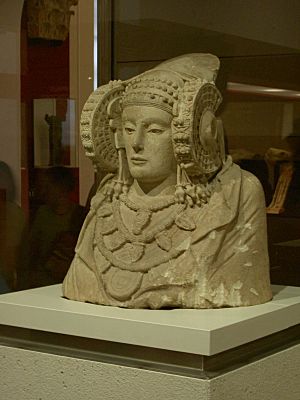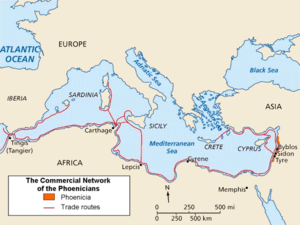Carthaginian Iberia facts for kids
Quick facts for kids
Iberia
|
|
|---|---|

Iberian sculpture, 3rd century BC, influenced by Carthaginian culture
|
Iberia, which is the land where modern-day Spain and Portugal are, had many trading connections with people called the Phoenicians. Later, another group called the Carthaginians took control of the Mediterranean parts of Iberia. They stayed there until big wars known as the Punic Wars happened. After these wars, the Romans took over the peninsula.
Contents
Who Were the Phoenicians and Carthaginians?
The Phoenicians were skilled traders from the eastern Mediterranean Sea. Their main cities were Tyre, Sidon, and Byblos. They set up many trading posts all around the Mediterranean, including some in what is now Spain.
Around 814 BC, the Phoenicians founded a very important city called Carthage. It was on the north African coast, in modern-day Tunisia. Later, when Phoenicia itself was taken over by other empires, Carthage became the most powerful Phoenician city. The Carthaginians then took control of many other Phoenician colonies. These included places in Sicily, Africa, and Sardinia.
The Spanish city of Cartagena was founded around 227 BC. It was built by a Carthaginian leader named Hasdrubal the Fair. He named it Qart Hadasht, which means 'New Town'. This was the same name as the original city of Carthage.
Carthage Expands into Iberia
After Carthage lost the First Punic War to Rome, they needed to find new ways to gain power. A Carthaginian general named Hamilcar Barca helped them. He put down a rebellion and trained a new army. This army included soldiers from Numidia and other hired fighters.
In 236 BC, Hamilcar led his army to Iberia. He wanted to build a new empire for Carthage there. This new empire would help make up for the lands they had lost to Rome. It would also be a base for future plans against the Romans.
Over eight years, Hamilcar gained a lot of land in Iberia. He used both fighting and talking to get control of about half of the Iberian Peninsula. Later, many Iberian soldiers joined the army of his son, Hannibal. Hannibal led this army into Italy to fight the Romans. However, Hamilcar died in battle in 228 BC. His death stopped him from finishing his conquest of Iberia. Soon after, the empire he had started began to fall apart.
The End of Carthaginian Rule in Iberia
The Carthaginian lands in Iberia were lost during the Second Punic War. In 209 BC, the Romans arrived in Iberia. Their army was led by Scipio Africanus. They captured the main Carthaginian stronghold in Iberia, which was called Nova Carthago (modern-day Cartagena).
After this, the Romans moved south. They fought the Carthaginian army of Hasdrubal Barca in the Battle of Baecula. But they could not stop him from going to Italy to help his brother Hannibal. The Carthaginians suffered a huge defeat at Ilipa in 206 BC. This battle sealed the fate of Carthaginian control in Iberia.
The Romans then captured Gades, a city that had already turned against Carthaginian rule. There was one last attempt by a Carthaginian leader named Mago in 205 BC. He tried to take back Cartago Nova. At that time, the Romans were having problems with a mutiny and an Iberian uprising. But Mago's attack was stopped. So, in the same year, he left Iberia. He sailed from the Balearic islands to Italy with his remaining soldiers.
Amazing Art from Ancient Iberia
There are four famous Iberian sculptures known as the "Ladies." These are the Lady of Cerro de los Santos, the Lady of Baza, the Lady of Guardamar, and the Lady of Elche. They were made around the 4th century BC.
The Lady of Guardamar was found in 1987. It is now in the Museum of Alicante. When the Lady of Elche was first found, people thought it showed Greek influence. But after the Lady of Guardamar was discovered in 1987, it changed how people thought. The Lady of Guardamar was found at a Phoenician (Carthaginian) site near Alicante. This made it seem more likely that the sculptures were influenced by Phoenician art.
These sculptures might have been used as special urns to hold ashes after someone died. Some people think the Elche bust was originally a full-body statue. There are also older sculptures from the 6th–5th century BC. These include mythical animals like the Bull of Osuna, the Sphinx of Agost, and the Bicha of Balazote. You can see these at the National Archaeological Museum of Spain in Madrid.
See also
- Carthaginian currency, including the Barcid mints in Iberia
- Timeline of Portuguese history
 In Spanish: Hispania cartaginesa para niños
In Spanish: Hispania cartaginesa para niños






